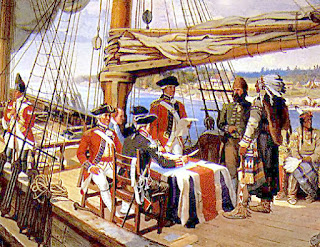 |
| Sir John Johnson carrying out the Toronto Purchase at the Bay of Quinte |
Such treaties established clear British title to lands needed for the resettlement of Loyalist refugees from the American Revolution. The future site of Toronto was covered by thick forest. Note that the surveyor used a tree as one of his survey markers.
The trail marked is the "Toronto Portage" (‘Carrying Place’ -N.) which connected Lake Ontario to the Holland River and Lake Simcoe; the route had long been used by Indians and fur traders.
The area labelled "Toronto" marks the site of the French trading fort abandoned 30 years earlier. The ruins, today near the bandshell in the CNE grounds, have recently been excavated.”
- Isobel Ganton & Joan Winearls, MAPPING TORONTO'S FIRST CENTURY 1787-1884
Images courtesy City of Toronto Archives (the archives record says ca. 1860??):
The Surveyor signature (if I’m not mistaken) appears to be that of William Chewett, Deputy Surveyor General of Upper Canada and father of James Chewett.
Further to the right on the document, the signatures to the Purchase:
Signing on behalf of the crown was William Claus, the deputy superintendent of Indian Affairs.
Interestingly, Library and Archives Canada features a version of the Plan of the Toronto purchase that is identical in content, but clearly a different copy. And yet the signatures appear to be the same:
The TPL has this map to contribute (note again how the Maple Tree serves as a key marker):
“Presented to the York Pioneers by William L. Baby in 1872, transferred to the Toronto Public Library, 1902. Part of manuscript volume "Indian Treaties".”
The story of the Toronto Purchase of 1787 is somewhat convoluted.
The Mississauga Indians surrendered 250,808 acres (101,528 hectares) of land to the British for some cash, ‘2,000 gun flints, 24 brass kettles, 10 dozen mirrors, 2 dozen laced hats, a bale of flowered flannel, and 96 gallons of rum’.
The Mississauga Indians surrendered 250,808 acres (101,528 hectares) of land to the British for some cash, ‘2,000 gun flints, 24 brass kettles, 10 dozen mirrors, 2 dozen laced hats, a bale of flowered flannel, and 96 gallons of rum’.
Unfortunately, there were irregularities and a dispute arose: Alexander Aitken’s surveys of 1788 did not match up with the area described by Sir John Johnson. Other chiefs complained that they had not been included in the negotiations. When Lieutenant-Governor John Graves Simcoe investigated the issue personally in 1792, he was able to uncover but a single document: a blank deed with no description of the land that had been purchased by the Crown, with the totems of the three Mississauga Chiefs.
In 1805 the new Lieutenant Governor of Ontario, Peter Hunter, decided to revisit the issue. The 1805 Indenture was a revision that more clearly set out the boundaries of the Purchase. Serious flaws with the handling of that treaty eventually led, two centuries later, to a $145 million settlement with the Mississaugas of New Credit First Nation.
I have glossed over the details: A reading of the Indian Claims Commission land claim report on the matter is highly recommended for history buffs (read the historical background section).
‘Original plan of the Toronto Purchase from the Indians, 1787-1805.’ - TPL
‘This map shows the original area covered by the Toronto Purchase (September 23, 1787). In 1911, when this map was made, Toronto covered only 10,477 of the 250,808 acres the government purchased from First Nations people for $9,500. The original belongs to the J. Ross Robertson Collection of maps, in the Toronto Reference Library.’ - TPL, This Weekend In History
‘Original plan of the Toronto Purchase from the Indians, 1787-1805.’ - TPL
‘This map shows the original area covered by the Toronto Purchase (September 23, 1787). In 1911, when this map was made, Toronto covered only 10,477 of the 250,808 acres the government purchased from First Nations people for $9,500. The original belongs to the J. Ross Robertson Collection of maps, in the Toronto Reference Library.’ - TPL, This Weekend In History
Please ‘Like’ and Share these maps with other Toronto history enthusiasts! (+1s are also welcome!)






